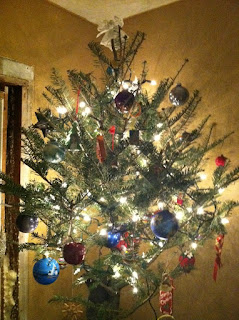Happy Holidays!
 |
| Charlie Brown trees look better in the dark. |
We are celebrating two overlapping holidays this year - the eight days of Chanukah and the twelve days of Christmas! Even for households that only celebrate Christmas, I'd strongly recommend celebrating all twelve days.
Multi-day holidays are wonderful for a number of reasons, but the reason most pertinent to this blog is that it allows for enjoying all your favorite holiday foods for many days, not just the one-time Christmas dinner. This is an excellent reason to work on clearing out your pantry and freezer of summer vegetables, canned tomatoes and that single pint jar of pickled peaches that you were saving for a special occasion.
Because I'm still a local-eating amateur, I didn't try to make Christmas Eve dinner, Christmas morning brunch and Christmas Day dinner all with completely local ingredients. Yes, I admit that this is a missed opportunity for a true challenge in local eating... but I'm okay with that - there's always next year. However, I did end up using a lot of local ingredients over the past few days, including that jar of pickled peaches.
When my mom was a teenager, she had really gotten into canning during the summertime and reminisces about the very small peaches that her family friend, Alice, had growing on a tree in her yard - they were perfect for pickling whole. However, I had never seen peaches small enough to fit into a canning jar; the ones coming from the orchard were all far too large. Not that I didn't believe my mom's story, but I never believed that I would find apricot-sized peaches unless I grew them on my own trees.
Imagine my happiness this summer when I found some very small peaches (selling for a dollar a pound!) at a local orchard and knew that they were destined for a sweet and vinegary brine. Even though I felt compelled to eat most of them fresh, I did manage to make a jar of whole pickled peaches.
For Christmas brunch, we had scrambled eggs, bison sausage in a balsamic-rosemary-maple reduction, pickled peaches and regular canned peaches, and my mom's Christmas danish in the shape of a candy cane. The pickled peaches, to my delight, didn't taste like vinegar as some pickles do - just spicy and a little bit sweet. Overall, it was a pretty good locally-sourced meal, minus the traditional must-have Christmas danish. (Full disclosure - the balsamic vinegar was from Italy and the rosemary from the high and dry lands near Telluride, CO. Thanks to Julie for farming out there and thanks to Angie for sharing the good herb!)
To make your own spiced pickled peaches, you should try the recipe in The Complete Book of Small Batch Preserving. There is also a recipe in the Ball Blue Book, which I have not tried.
Source citations:
Eggs - six happy hens in the backyard
Milk - McNamara Dairy
Feta cheese (in some but not all of the scrambled eggs) - from Wisconsin
Bison sausage - Yankee Farmers Market in Warner
Balsamic vinegar - Italy
Rosemary - Colorado
Maple syrup - sugar maple trees in the backyard
Peaches - home-canned, from Carter Hill and Gould Hill Orchards
Christmas danish - from my mom



